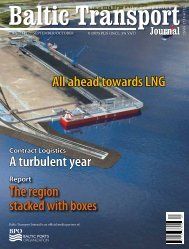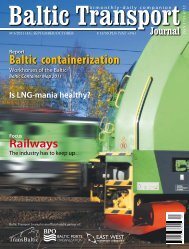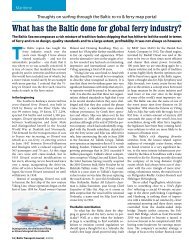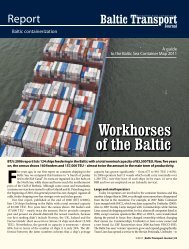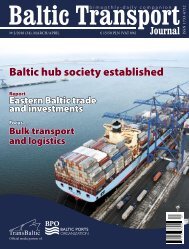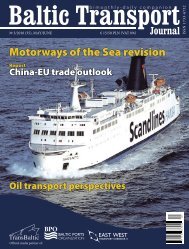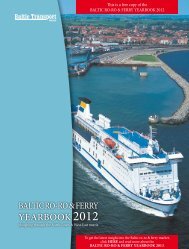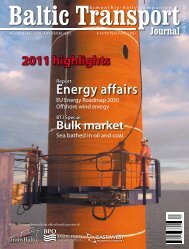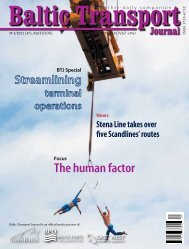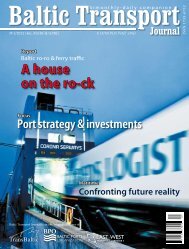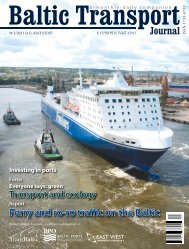Create successful ePaper yourself
Turn your PDF publications into a flip-book with our unique Google optimized e-Paper software.
Report<br />
Machinery for severe climate<br />
conditions<br />
An interview with Oleg F. Yermolayev, General Director of Baltkran<br />
History of the Russian crane manufacturer Baltkran from Kaliningrad<br />
spreads over 60 years but it’s only in the last 13 that you have<br />
worked under free-market conditions. Is it not difficult to compete<br />
with the West European companies that have well established their<br />
reputation in the world’s harbour crane market?<br />
Baltkran has developed dynamically over the period of 63 years. During this<br />
time, it has produced more than 13,500 cranes of various types. And we have<br />
come quite a long way since our first rivet crane – with its lifting capacity of 6.3<br />
tons, its simple mechanisms and steering system, and its primitive cabin for a<br />
crane operator. There’s no comparison to the modern, complicated and mighty<br />
container cranes we produce now. Baltkran not only survived the transformation<br />
from the socialist planned economy to a market economy but, having consolidated,<br />
we have carried out a thorough reorganization of the enterprise on a<br />
daily basis. Presently, we hold good positions in the niche areas chosen by the<br />
company’s directorship. The period of time referred to in your question is not<br />
that short at all. Everyone has begun from scratch at one time or another. When<br />
our main shareholder – the Noell concern from Germany – obtained our company’s<br />
shares from the government and then realized orders for modern and<br />
complex equipment, it took upon itself the responsibility to share with Baltkran<br />
its long-standing experience in deliveries to large ports.<br />
Which countries prevail among the clients who purchase your products?<br />
Delivery of equipment and complex crane parts is carried out both to<br />
domestic and to foreign markets like: France, Holland, Finland, Germany,<br />
USA, China, India and also Lithuania, Belarus, Kazakhstan and<br />
many more.<br />
Some of your equipment is to be used in severe climate conditions.<br />
How can you assure the safety of its usage?<br />
Ensuring safety is our credo. We are one of the few companies with many<br />
years of experience in delivering lifting equipment to areas with critically low<br />
temperatures (down to 60°C) in Eastern and Western Siberia, Iakutia, and beyond<br />
the Arctic Circle. What is more, we have had a large number of positive<br />
replies from our clients. And we have no less experience in delivering products<br />
to regions with sumptuous and long-lasting annual atmospheric fall, in<br />
particular snowfall, strong storm winds and others. The crate-like construction<br />
of cranes ensures stability when hurricane winds set in and it also prevents<br />
the snow from accumulating. For this purpose, a specially constructed<br />
spreader was designed, whose gripping devices are placed on top thereby allowing<br />
to grip the container without fail and in a reliable manner even with<br />
a huge snow-drift on it. In seismic sensitive areas, special technological solutions<br />
have been implemented which ensure the stability of equipment also in<br />
case of an earthquake of 7 degrees on the Richter scale.<br />
How do your products meet present ecological standards?<br />
First of all, we produce equipment which does not require the use of diesel<br />
oil. Our cranes and even the separate crane parts are operated with<br />
the use of electrical power. This is why, we only use electrical spreaders<br />
instead of the hydraulic ones for reloading containers. The use of noiseless<br />
operating systems is yet another important factor, which enables<br />
our cranes to be operated in terminals located in inhabited areas.<br />
32 | <strong>Baltic</strong> <strong>Transport</strong> <strong>Journal</strong> | 3/<strong>2008</strong><br />
It seems like Baltkran benefited a lot from the Russian extractive<br />
industry boom. Is your development strategy focused more on cooperation<br />
with existing clients from that branch or are you searching<br />
for new customers?<br />
In the wake of the dynamic growth in the Russian economy within<br />
the last decades, such branches as the oil and gas industries, black and<br />
colour metallurgy, transport and others have much developed. Currently,<br />
one can observe a real increase in the number of new production<br />
plants in Russia and in the modernization of the already existing<br />
ones, which naturally entails additional investments in equipment and<br />
technology. The majority of our clients are big players on the global<br />
markets like Lukoil, Surgutneftegas, Gazprom, RŽD, Atomstroiexport.<br />
They have established stable and partner relations with us over<br />
the period of many years. At the same time, the circle of our clients<br />
has steadily been growing with new companies both from Russia and<br />
abroad – Stal, NCC, Alrosa (based at the river port of Ust-Kut), companies<br />
from Kazakhstan, Germany… We believe others will follow.<br />
Taking into account further seaports’ dynamic development, in<br />
what direction should the equipment and services offered on the<br />
market evolve?<br />
One can characterize all the tendencies related to the development of<br />
the lifting equipment market by saying that it is ‘maximum efficiency<br />
and minimum loss’ in the area of exploitation that is being sought<br />
after. This also means that technology should be reliable, repairable,<br />
economical, and that it should have a high working capacity. In the<br />
countries where the level of technical culture is high – the USA, Germany,<br />
Holland and others – the working force is costly and hence a<br />
fully automated operating system will be preferred there. Naturally,<br />
there will be more pressure for keeping up with ecological and safety<br />
standards as far as materials and equipment are concerned.<br />
Aleksandra Wiśniewska



